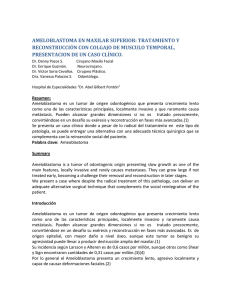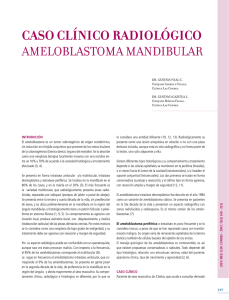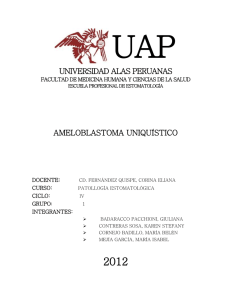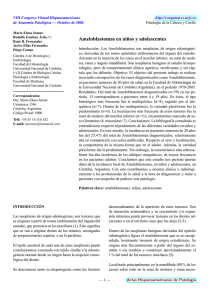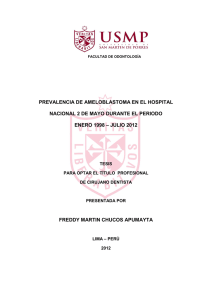Diagnóstico citológico de las recidivas tumorales de ameloblastoma
Anuncio
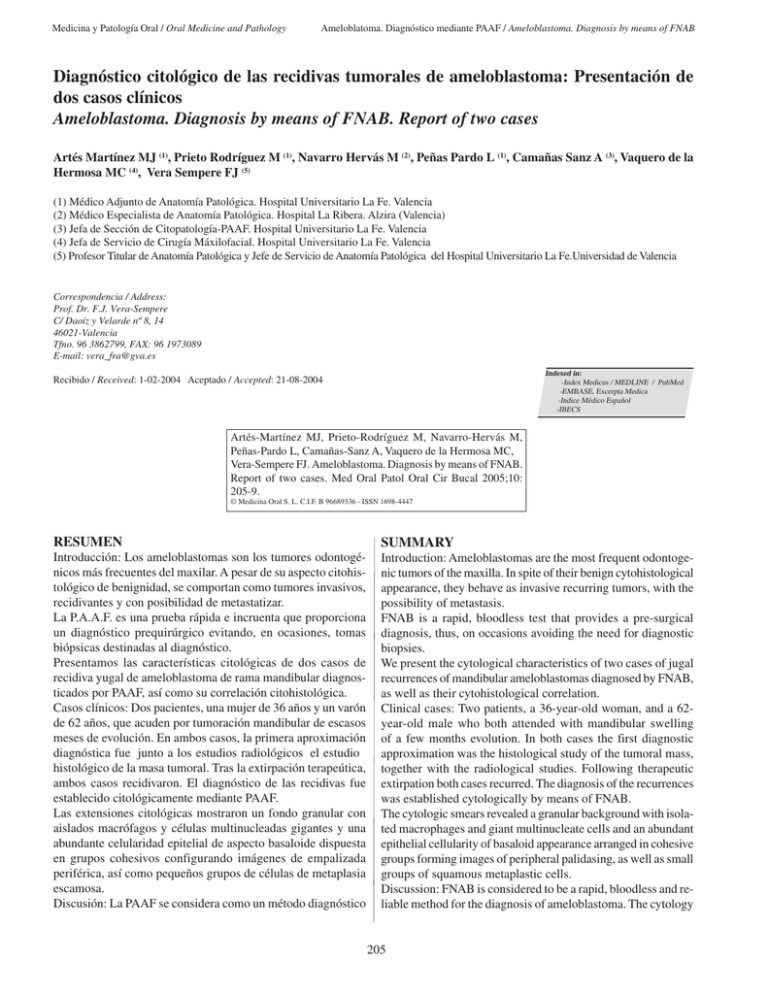
Medicina y Patología Oral / Oral Medicine and Pathology Ameloblatoma. Diagnóstico mediante PAAF / Ameloblastoma. Diagnosis by means of FNAB Diagnóstico citológico de las recidivas tumorales de ameloblastoma: Presentación de dos casos clínicos Ameloblastoma. Diagnosis by means of FNAB. Report of two cases Artés Martínez MJ (1), Prieto Rodríguez M (1), Navarro Hervás M (2), Peñas Pardo L (1), Camañas Sanz A (3), Vaquero de la Hermosa MC (4), Vera Sempere FJ (5) (1) Médico Adjunto de Anatomía Patológica. Hospital Universitario La Fe. Valencia (2) Médico Especialista de Anatomía Patológica. Hospital La Ribera. Alzira (Valencia) (3) Jefa de Sección de Citopatología-PAAF. Hospital Universitario La Fe. Valencia (4) Jefa de Servicio de Cirugía Máxilofacial. Hospital Universitario La Fe. Valencia (5) Profesor Titular de Anatomía Patológica y Jefe de Servicio de Anatomía Patológica del Hospital Universitario La Fe.Universidad de Valencia Correspondencia / Address: Prof. Dr. F.J. Vera-Sempere C/ Daoíz y Velarde nº 8, 14 46021-Valencia Tfno. 96 3862799, FAX: 96 1973089 E-mail: vera_fra@gva.es Indexed in: -Index Medicus / MEDLINE / PubMed -EMBASE, Excerpta Medica -Indice Médico Español -IBECS Recibido / Received: 1-02-2004 Aceptado / Accepted: 21-08-2004 Artés-Martínez MJ, Prieto-Rodríguez M, Navarro-Hervás M, Peñas-Pardo L, Camañas-Sanz A, Vaquero de la Hermosa MC, Vera-Sempere FJ. Ameloblastoma. Diagnosis by means of FNAB. Report of two cases. Med Oral Patol Oral Cir Bucal 2005;10: 205-9. © Medicina Oral S. L. C.I.F. B 96689336 - ISSN 1698-4447 RESUMEN SUMMARY Introducción: Los ameloblastomas son los tumores odontogénicos más frecuentes del maxilar. A pesar de su aspecto citohistológico de benignidad, se comportan como tumores invasivos, recidivantes y con posibilidad de metastatizar. La P.A.A.F. es una prueba rápida e incruenta que proporciona un diagnóstico prequirúrgico evitando, en ocasiones, tomas biópsicas destinadas al diagnóstico. Presentamos las características citológicas de dos casos de recidiva yugal de ameloblastoma de rama mandibular diagnosticados por PAAF, así como su correlación citohistológica. Casos clínicos: Dos pacientes, una mujer de 36 años y un varón de 62 años, que acuden por tumoración mandibular de escasos meses de evolución. En ambos casos, la primera aproximación diagnóstica fue junto a los estudios radiológicos el estudio histológico de la masa tumoral. Tras la extirpación terapeútica, ambos casos recidivaron. El diagnóstico de las recidivas fue establecido citológicamente mediante PAAF. Las extensiones citológicas mostraron un fondo granular con aislados macrófagos y células multinucleadas gigantes y una abundante celularidad epitelial de aspecto basaloide dispuesta en grupos cohesivos configurando imágenes de empalizada periférica, así como pequeños grupos de células de metaplasia escamosa. Discusión: La PAAF se considera como un método diagnóstico Introduction: Ameloblastomas are the most frequent odontogenic tumors of the maxilla. In spite of their benign cytohistological appearance, they behave as invasive recurring tumors, with the possibility of metastasis. FNAB is a rapid, bloodless test that provides a pre-surgical diagnosis, thus, on occasions avoiding the need for diagnostic biopsies. We present the cytological characteristics of two cases of jugal recurrences of mandibular ameloblastomas diagnosed by FNAB, as well as their cytohistological correlation. Clinical cases: Two patients, a 36-year-old woman, and a 62year-old male who both attended with mandibular swelling of a few months evolution. In both cases the first diagnostic approximation was the histological study of the tumoral mass, together with the radiological studies. Following therapeutic extirpation both cases recurred. The diagnosis of the recurrences was established cytologically by means of FNAB. The cytologic smears revealed a granular background with isolated macrophages and giant multinucleate cells and an abundant epithelial cellularity of basaloid appearance arranged in cohesive groups forming images of peripheral palidasing, as well as small groups of squamous metaplastic cells. Discussion: FNAB is considered to be a rapid, bloodless and reliable method for the diagnosis of ameloblastoma. The cytology 205 Med Oral Patol Oral Cir Bucal 2005;10:205-9. Ameloblatoma. Diagnóstico mediante PAAF / Ameloblastoma. Diagnosis by means of FNAB rápido, incruento y fiable en el diagnóstico del ameloblastoma. La citología de estos tumores revela los componentes de la lesión que, en general, son suficientes para llegar al diagnóstico de ameloblastoma, especialmente en casos de recidiva. of these tumors reveals components of the lesion that, in general, are sufficient for the diagnosis of ameloblastoma, especially in cases of recurrence. Key words: Ameloblastoma, FNAB, recurrence. Palabras clave: Ameloblastoma, PAAF, recidiva. INTRODUCTION INTRODUCCION Los maxilares, al igual que otras estructuras óseas, pueden verse afectados por distintas enfermedades esqueléticas, localizadas o generalizadas. Al mismo tiempo el asiento maxilar de las estructuras dentales, puede ser origen de numerosas lesiones inflamatorias, quísticas o tumorales. El ameloblastoma es el tumor odontogénico más frecuente (1). Representa el 1% de todas las lesiones (quísticas o tumorales) mandibulares. Deriva del epitelio odontogénico, aunque también puede surgir a partir de remanentes celulares del órgano del esmalte o bien de la capa basal de la mucosa oral (2). Clínicamente se manifiesta como una tumoración frecuentemente indolora que puede acompañarse de deformidad facial, maloclusión, pérdida de piezas dentales, ulceración y enfermedad periodontal (3,4). Aparece con más frecuencia en la tercera o cuarta década de la vida, aunque se han descrito casos en niños (5). Histológicamente, el ameloblastoma se caracteriza por la proliferación de células epiteliales que se disponen sobre un estroma de tejido conjuntivo vascular en estructuras localmente invasoras que recuerdan el órgano del esmalte en distintos estadios de diferenciación. Se han descrito diversos patrones histológicos (folicular, plexiforme, acantomatoso, papilífero-queratósico, desmoplásico, de células granulares, vascular y con inducción dentinoide) (6,7) y, en un mismo tumor, suelen observarse dos o más patrones, no existiendo evidencia de que los distintos patrones comporten un diferente pronóstico. Se trata de un tumor invasivo y recidivante, reservándose el término de ameloblastoma maligno únicamente en aquellos tumores metastásicos que conservan la morfología típica del ameloblastoma (8). La PAAF no suele ser el primer método de diagnóstico en estas lesiones, quizás debido a que el abordaje de las mismas mediante biopsia incisional es fácil y de rápida ejecución. El estudio citológico, sin embargo, puede ser muy útil en el caso de enfermedad metastásica o en el seguimiento de posibles recidivas (9,10). La citología revela los componentes de la lesión, identificándose generalmente sobre un fondo granular, una característica combinación de células epiteliales de aspecto basaloide, células de metaplasia escamosa y células con rasgos de retículo estrellado, no siendo infrecuente el hallazgo de macrófagos y de células multinucleadas gigantes. Estos hallazgos, en conjunción con los datos clínicos y radiológicos, son suficientes para un diagnóstico citológico correcto de ameloblastoma (11). Los dos casos clínicos que a continuación presentamos ilustran el gran beneficio que pueden obtener estos pacientes de una prueba rápida e incruenta (PAAF) que proporciona un diagnóstico prequirúrgico evitando, en muchas ocasiones, la cirugía con finalidad diagnóstica. The maxillae, as with other bone structures, can become affected by different localized or widespread skeletal diseases. At the same time, the maxillary location of the dental structures can be the origin of numerous cystic or tumoral inflammatory lesions. Ameloblastoma is the most frequent odontogenic tumor (1). It represents 1% of all mandibular lesions (cystic or tumoral). It derives from odontogenic epithelium, although it can also arise from cellular remnants of the enamel organ or of the basal layer of the oral mucosa (2). Clinically, it frequently manifests as a painless swelling, which can be accompanied by facial deformity, malocclusion, loss of dental pieces, ulceration and periodontal disease (3,4). It appears with greater frequency in the third or fourth decade of life, although cases have been described in children (5). Histologically, ameloblastoma is characterized by the proliferation of epithelial cells arranged on a stroma of conjunctive vascular tissue in locally invading structures that resemble the enamel organ at different stages of differentiation. Diverse histological patterns have been described (follicular, plexiform, acanthomatous, papilliferous-keratotic, desmoplastic, of granular cells, vascular and with dentinoid induction) (6,7). Two or more patterns are usually observed in the same tumor, although no evidence exists as to whether the different patterns provide a different prognosis. It is an invasive and recurring tumor, the term malignant ameloblastoma being reserved only for those metastatic tumors that preserve the typical morphology of ameloblastoma (8). FNAB is not usually the first diagnostic method in these lesions, probably due to the fact that an incisional biopsy is easily and rapidly carried out. Nevertheless, the cytological study, can be very useful in cases of metastatic disease or in the follow-up of possible recurrences (9,10). The cytology reveals components of the lesion with a characteristic combination of epithelial cells of basaloid appearance, squamous metaplastic cells and cells resembling stellate reticulum; generally identified on a granular background. The finding of macrophages and giant multinucleate cells is quite common. These findings, in conjunction with the clinical and radiological information, are sufficient for a correct cytologic diagnosis of ameloblastoma (11). The two clinical cases presented below illustrate the great benefit that can be obtained for these patients by a rapid and bloodless test (FNAB) that provides a pre-surgical diagnosis, on many occasions avoiding diagnostic surgery. CLINICAL CASES Case nº 1: A 36-year-old woman, with no previous history of interest, who came to the Maxillofacial Surgery Service with a 206 Medicina y Patología Oral / Oral Medicine and Pathology Ameloblatoma. Diagnóstico mediante PAAF / Ameloblastoma. Diagnosis by means of FNAB CASOS CLINICOS Caso nº 1: Mujer de 36 años, sin antecedentes de interés, que acude al Servicio de Cirugía Máxilofacial por mostrar una tumoración mandibular izquierda de crecimiento progresivo, de 5 meses de evolución. La exploración radiológica (RX y TAC) mostró una gran masa mandibular derecha (tercio distal de rama ascendente) con rotura de cortical externa e interna. El estudio histológico biópsico reveló la existencia de un ameloblastoma de patrón mixto folicularplexiforme, realizando abordaje terapeútico de la lesión, con una hemimandibulectomía izquierda. Tras 4 años de evolución libre de enfermedad, la paciente presenta de nuevo tumoración mandibular izquierda que protuye hacia la cavidad oral. En esta ocasión, el diagnóstico fue citológico, practicándose dos PAAF que confirmaron la recidiva de ameloblastoma, permaneciendo la paciente libre de enfermedad tumoral en el momento actual (36 meses). Caso nº 2: Varón de 66 años con antecedentes de diabetes mellitus tipo II que acude al Servicio de Cirugía Máxilofacial por tumoración mandibular derecha de 2 meses de evolución. La radiología mostró una tumoración multiquística en trígono retromolar mandibular derecho con afectación del lóbulo profundo parotídeo. El material histológico procedente de la osteotomía marginal realizada mostró la existencia de un ameloblastoma de patrón mixto folicular-plexiforme. Tras esta primera resección, el paciente ha sufrido 5 recidivas hasta el momento actual (julio de 2003), llegando a afectar músculos masetero y pterigoideo así como el paladar, a pesar de persistir, en todas las intervenciones quirúrgicas, los extremos de resección libres de infiltración tumoral. En todas esta recidivas, la primera aproximación diagnóstica fue la PAAF, siendo suficiente para diagnóstico en todos los casos. La celularidad obtenida en ambos casos, en los que se practicó un total de 6 punciones (una en el caso nÀ 1 y cinco en el caso nÀ 2) fue variable, observándose únicamente aislados grupos de células epiteliales monomorfas en las extensiones correspondientes a las punciones del primer caso (fig.1). Sin embargo, el material aspirado en las punciones del caso nÀ 2 mostró, en todas las ocasiones, abundante celularidad epitelial en un fondo granular que contenía abundantes macrófagos, aisladas células multinucleadas gigantes y pequeños grupos celulares con rasgos de metaplasia escamosa. La celularidad epitelial, en ambos casos, estaba constituida por placas monocapa de células de aspecto basaloide, de núcleos hipercromáticos elongados sin atipia manifiesta y citoplasmas escasos mal definidos. La disposición celular era tanto disociada como en placas. Las placas, con frecuencia, presentaban disposición celular periférica en „empalizada‰ (fig.2), observándose ribetes de células elongadas situadas de forma paralela delimitando el contorno de las placas. El estudio histológico biópsico reveló, en el primer caso, la existencia de un ameloblastoma de patrón mixto que afectaba la rama mandibular izquierda, con presencia tanto de áreas de tipo folicular -con presencia de nidos tapizados por una única capa de progressively growing tumor on the left mandible, of 5 months of evolution. The radiological exploration (X-Ray and CAT) showed a large right mandibular mass (third distal ramus ascendens) with an external and internal cortical break. The histological study of the biopsy revealed the existence of an ameloblastoma of mixed follicular-plexiform pattern. A therapeutic approach to the lesion was made, carrying out a left hemimandibulectomy. After 4 years free of disease the patient presented again with a swelling on the left mandible protuding towards the oral cavity. On this occasion, the diagnosis was cytologic, carrying out two FNAB that confirmed the recurrence of ameloblastoma, the patient remaining free of tumoral disease at the present time (36 months). Case nº 2: A 66-year-old male with precedents of type II diabetes mellitus, who came to the Maxillofacial Surgery Service with a tumor pertaining to the right mandible of 2 months evolution. The radiology revealed a multicystic tumor in the retromolar trigonum of the right mandibula with involvement of the deep parotid lobe. The histological material proceeding from the marginal osteotomy carried out showed the existence of an ameloblastoma of mixed follicular-plexiform pattern. Following this first resection, the patient has suffered 5 recurrences up to the present time (July, 2003), affecting the masseter and pterygoid muscles as well as the palate, in spite of maintaining resection limits free of tumoral infiltration in all the surgical interventions. For all the recurrences, the first diagnostic approximation was an FNAB, this being sufficient for diagnosis in all the cases. The cellularity obtained in both cases, in which a total of 6 punctures were practised (one in case nÀ 1 and five in case nÀ 2), was variable; isolated groups of monomorphic epithelial cells only being observed in the smears from the first case (fig.1). Nevertheless, the material aspirated in the punctures of case nÀ 2 showed, on all occasions, abundant epithelial cellularity on a granular background containing abundant macrophages, isolated giant multinucleate cells and small cellular groups with features of squamous metaplasia. In both cases, the epithelial cellularity, consisted of monolayered plates of cells of basaloid appearance, with elongated hyperchromatic nuclei, no evident atypia and scant, poorly defined cytoplasm. The cellular arrangement was isolated as well as in cellular plates. The plates frequently presented a cellular peripheral palisade arrangement (fig.2), observing elongated cellular borders arranged in parallel and delimiting the outline of the plates. In the first case, the histological study of the biopsy revealed the existence of an ameloblastoma of mixed pattern affecting the left mandibular ramus, having both follicular type areas - with the presence of nests covered by a single layer of columnars cells with subnuclear vacuoles and centred with stellate cells - and plexiform areas, made up of anastomosed cords and epithelial cells. The histological pattern of the second case revealed a multicystic growth affecting the mandibula and right parotid (deep lobe) of predominantly follicular pattern. 207 Med Oral Patol Oral Cir Bucal 2005;10:205-9. Ameloblatoma. Diagnóstico mediante PAAF / Ameloblastoma. Diagnosis by means of FNAB Fig.1. (caso nÀ1): Placas con disposición celular periférica en „empalizada‰. May-Grünwald-Giemsa 100 x. (case nº1): Cytological appearance of a cellular sheet with peripheral palisading. Diff Quick 100x. Fig. 2. (caso nÀ2): Placas monocapa de células de aspecto basaloide con núcleos hipercromáticos elongados sin atipia manifiesta y citoplasmas escasos mal definidos. Papanicolaou 200 x. (case nº2): Basaloid cells in monolayered sheet showing nuclear hypercrhomasia whithout atypia, with a scant and no apparent cytoplasm.Papanicolaou 200 x. células columnares con vacuolas subnucleares y centrados por células estrelladas- como plexiforme, constituidas por cordones anastomosados, asimismo, de células epiteliales. El cuadro histológico correspondiente al segundo caso mostró una tumoración multiquística con afectación mandibular y parotídea derecha (lóbulo profundo) de patrón predominante folicular. DISCUSSION DISCUSION El ameloblastoma es un tumor benigno, aunque localmente invasivo, con tendencia a recurrir -incluso tras resecciones satifactorias-, pudiendo opcionalmente sufrir transformación maligna e incluso metastatizar (8,9,10). Parece ser que la recurrencia depende de diversos factores, tales como: carácter multiquístico, método de tratamiento de la lesión primaria, extensión de la lesión y lugar de origen. Actualmente, el tratamiento de elección es la maxilectomía parcial con un márgen de 10-15 mm. de hueso sano que incluya el borde alveolar, el paladar duro, la mucosa del seno maxilar y la pared lateral nasal (12). A nivel citológico muestra unos rasgos característicos, con una combinación de células epiteliales de aspecto basaloide, células de metaplasia escamosa y células con rasgos de retículo estrellado, siendo asimismo frecuente la presencia de macrófagos y de células multinucleadas gigantes. En ocasiones, pueden plantearse problemas de diagnóstico diferencial con el fibroma ameloblástico (otro tumor odontogénico con rasgos radiológicos en ocasiones similares al ameloblastoma) y con los tumores de glándula salival. Los tumores salivales de localización intraósea son excepcioonales y están representados, fundamentalmente, por el carcinoma adenoide quístico, carcinoma mucoepidermoide y el carcinoma de células acinares, todos ellos con componentes celulares y extracelulares típicos („bolas‰ de material metacromático, material mucoide, etc.) que, generalmente, no dan lugar a problemas de diagnóstico diferencial. Ameloblastoma is a benign, though locally invasive tumor, with a tendency to recurr - even after satisfactory resection. It is able to undergo either malignant transformation or even metastasis (8,9,10). It seems that recurrence depends on diverse factors, such as: multicystic character, the method of treatment of the primary lesion, extent of the lesion and site of origin. Now, the treatment of choice is a partial maxillectomy with a margin of 10-15 mm of healthy bone that includes the alveolar edge, the hard palate, the maxillary sinus mucosa and the lateral nasal wall (12). At the cytological level it demonstrates some typical features, with a combination of epithelial cells of basaloid appearance, squamous metaplastic cells and cells with features of stellate reticulum, and likewise, the frequent presence of macrophages and giant multinucleate cells. On occasions, it can raise differential diagnostic problems with ameloblastic fibroma (another odontogenic tumor with radiological features on occasions similar to those of ameloblastoma) and with tumors of the salivary gland. Salivary tumors of intraosseous location are rare and represented, fundamentally, by adenoid cystic carcinoma, mucoepidermoid carcinoma and carcinoma of acinar cells, all with cellular and extracellular components („balls‰ of metachromatic material, mucoid material, etc.), so typical that they do not generally give rise to differential diagnostic problems. Both clinical cases presented here illustrate how cytology by FNAB, in a suitable clinico pathological context, facilitates the establishment of a differential diagnosis. In our opinion, it is a very useful tool in the diagnosis of recurrences of ameloblastoma, permitting a rapid, innocuous, economic and reliable diagnosis. 208 Medicina y Patología Oral / Oral Medicine and Pathology Ameloblatoma. Diagnóstico mediante PAAF / Ameloblastoma. Diagnosis by means of FNAB Los dos casos clínicos que presentamos ilustran, por lo tanto, como la citología por PAAF, en un adecuado contexto clínicopatológico, permite establecer estos diagnósticos diferenciales siendo, a nuestro juicio, una herramienta muy útil en el diagnóstico de las recidivas de ameloblastoma, permitiendo un diagnóstico rápido, inocuo, económico y fiable. BIBLIOGRAFIA/REFERENCES 1. Laarson A, Almeren H. Ameloblastoma of the jaws. Acta Pathol Microbiol Scand 1978;86:337-49. 2. Wesley RK, Borninski ER, Mintz S. Peripheral ameloblastoma. Report of a case and review of the literature. J Oral Surg 1977;35:670-2. 3. Meshlisch DR, Dahlin DC, Masson JK. Ameloblastoma: a clinicopathologic report. J Oral Surg 1972;30:9-22. 4. Miyamoto CT, Brady LW, Markoe A, Salinger D. Ameloblastoma of the jaw: Treatment with radiation therapy and case report. Am J Clin Oncol 1991;14: 225-30. 5. Sehdev MK, Huvos AG, Strong EW, Gerold FP, Willis GW. Ameloblastoma of maxilla and mandible. Cancer 1974;33:324-33. 6. Higuchi Y, Nakamura N, Ohishi M, Tashiro H. Unusual ameloblastoma with extensive stromal desmoplasia. J Craniomaxillofac Surg 1991;19:323-7. 7. Burkes EJ, Wallace DA. Granullar cell ameloblastoma. J Oral Surg 1976;34: 742-4. 8. Kunze E, Donath K, Luhr HG, Engelhardt W, De Vivie R. Biology of metastasizing ameloblastoma. Pathol Res Pract 1985;180:526-35. 9. Levine SE, Mossler JA, Jhonston WW. The cytologic appearance of metastasic ameloblastoma. Acta Cytol 1981;5:295-6. 10. Parate SN, Anshu, Helwatkar SB, Munshi MM. Cytology of recurrent ameloblastoma with malignant change. A case report. Acta Cytol 1999;43:1105-7. 11. Mathew S, Rappaport K, Ali SZ, Busseners AE, Rosenthal DL. Ameloblastoma with extensive stromal desmoplasia. J Craniomaxillofac Surg 1991;41: 955-60. 12. Zwalhen RA, Gratz KW. Maxillary ameloblastomas: a review of the literature and of a 15-year database. J Craniomaxillofac Surg 2002;30:273-9. 209
